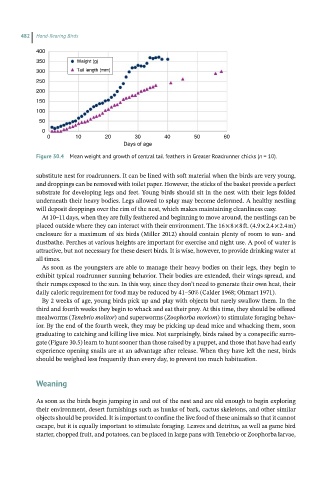Page 486 - Hand rearing birds second
P. 486
482 Hand-Rearing Birds
400
350 Weight (g)
300 Tail length (mm)
250
200
150
100
50
0
0 10 20 30 40 50 60
Days of age
Figure 30.4 Mean weight and growth of central tail feathers in Greater Roadrunner chicks (n = 10).
substitute nest for roadrunners. It can be lined with soft material when the birds are very young,
and droppings can be removed with toilet paper. However, the sticks of the basket provide a perfect
substrate for developing legs and feet. Young birds should sit in the nest with their legs folded
underneath their heavy bodies. Legs allowed to splay may become deformed. A healthy nestling
will deposit droppings over the rim of the nest, which makes maintaining cleanliness easy.
At 10–11 days, when they are fully feathered and beginning to move around, the nestlings can be
placed outside where they can interact with their environment. The 16 × 8 × 8 ft. (4.9 × 2.4 × 2.4 m)
enclosure for a maximum of six birds (Miller 2012) should contain plenty of room to sun‐ and
dustbathe. Perches at various heights are important for exercise and night use. A pool of water is
attractive, but not necessary for these desert birds. It is wise, however, to provide drinking water at
all times.
As soon as the youngsters are able to manage their heavy bodies on their legs, they begin to
exhibit typical roadrunner sunning behavior. Their bodies are extended, their wings spread, and
their rumps exposed to the sun. In this way, since they don’t need to generate their own heat, their
daily caloric requirement for food may be reduced by 41–50% (Calder 1968; Ohmart 1971).
By 2 weeks of age, young birds pick up and play with objects but rarely swallow them. In the
third and fourth weeks they begin to whack and eat their prey. At this time, they should be offered
mealworms (Tenebrio molitor) and superworms (Zoophorba moriom) to stimulate foraging behav-
ior. By the end of the fourth week, they may be picking up dead mice and whacking them, soon
graduating to catching and killing live mice. Not surprisingly, birds raised by a conspecific surro-
gate (Figure 30.5) learn to hunt sooner than those raised by a puppet, and those that have had early
experience opening snails are at an advantage after release. When they have left the nest, birds
should be weighed less frequently than every day, to prevent too much habituation.
Weaning
As soon as the birds begin jumping in and out of the nest and are old enough to begin exploring
their environment, desert furnishings such as hunks of bark, cactus skeletons, and other similar
objects should be provided. It is important to confine the live food of these animals so that it cannot
escape, but it is equally important to stimulate foraging. Leaves and detritus, as well as game bird
starter, chopped fruit, and potatoes, can be placed in large pans with Tenebrio or Zoophorba larvae,

